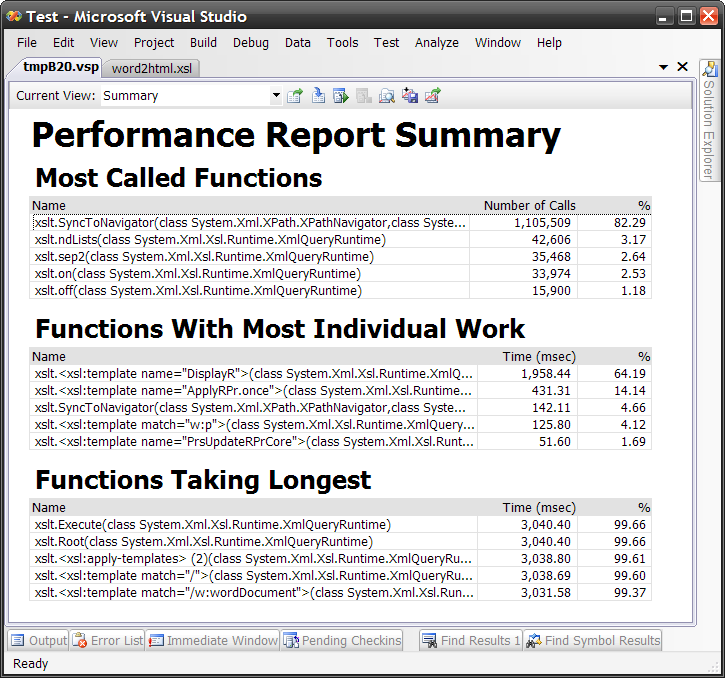February 20, 2008
Obfuscating XSLT
Inspired by ioccc.org, just for fun, really. Can you figure out what this stylesheet outputs (without running it of course)?
<!DOCTYPE p [
<!ENTITY _0_ 'string'>
<!ENTITY _0-0_ 'sub&_0_;'>
]>
<p x:version="1.0" xmlns:x="http://www.w3.org/1999/XSL/Transform">
<x:variable name="_" select="document('')"/>
<x:variable name="_-_" select="number(not(_-_=_-_=_-_=_-_))"/>
<x:value-of select="concat(
&_0-0_;(namespace-uri($_/*/*[$_-_]), $_-_, $_-_),
&_0-0_;(name($_/*/*[$_-_]), &_0_;-length(*>*)*2, $_-_),
&_0-0_;(@_>_-, &_0_;-length(******* div @_), $_-_),
translate(name(($_//@*)[5]), translate(name(($_//@*)[5]), 'l', ''), ''),
&_0-0_;($_//namespace::*, &_0_;-length($_-_ div 0)+7, $_-_), ' ',
&_0-0_;-after(&_0-0_;-before($_//namespace::*, 3), '.'),
&_0-0_;($_//namespace::*, 15, 2),
&_0-0_;(_/_/_=//_//_, 3, $_-_),
&_0-0_;($_/*/*/@*[contains(.,'(')], $_-_, $_-_), '!')"/>
</p>
By the way, does anybody think XSLT obfuscator is a useful tool?
February 11, 2008
Microsoft XSLT Profiler
Microsoft XML Tools team has released XSLT profiler addin for Visual Studio 2008. I've heard about this tool and even did a little testing long time ago (apparently it's very hard to release anything in Microsoft).
First thing you need to know about Microsoft XSLT profiler - it requires Visual Studio 2008 Team System edition with the Performance Tools feature installed. That actually sounds a bit steep for just XSLT profiler, but it starts to make sense once you realize this tool is just a thin wrapper around the F1 profiler (which only ships with Visual Studio Team System SKU).
Once installed, it adds "Profile XSLT" command (visible only in XSLT context, i.e. when active document is XSLT stylesheet) to the XML menu:
Before you see profiling results you should recall that XSLT in .NET starting with 2.0 is compiled to MSIL:

As you can see, an XSLT stylesheet is being compiled into a class and each template becomes a method with cool special name like <xsl:template match="book">. That was smart. And yes, MSIL is completely ok with such kind of method names. Beside template-mehods the generated class contains other auxiliary stuff. So don't be surprised with XSLT profiling results:

I'd say there is too much clutter in this form. I'd like to see only XSLT relevant info, but as you can understand now, it's the the results of profiling compiled assembly and XSLT part is here only because smart compilation tricks.
Still extremely useful tool. A must for anybody writing XSLT in Visual Studio. Besides Summary View there are: Call Tree View, Modules View, Caller/Callee, Functions, Marks and Processes Views. You can find more info about profiling report details at http://code.msdn.microsoft.com/xsltprofiler.
I'd be happy to see next version. With all clutter removed, more XSLT focused, linked to XSLT source (seems like currently there is no way to get back to template source from report), may be with some smart visualizations (what about coloring XSLT source view to indicate the hot spots?). Oh well, provided it took XML Tools team so long to ship this tool I better try to implement all these ideas myself in Iron XSLT (stay tuned, it's not dead as I'm back).
February 8, 2008
New XSLT stylesheet template in Visual Studio 2008 (again)
When you create new XSLT stylesheet in Visual Studio via project (Add/New Item) or globally (File/New/File aka Ctrl+N), you start with template content. This template is changing in every new Visual Studio version, probably because every new generation of developers working on XSLT tools in Visual Studio have different vision about what you should start with.
Let's see. Visual Studio 2003. Pure simplicity:
<?xml version="1.0" encoding="UTF-8" ?> <stylesheet version="1.0" xmlns="http://www.w3.org/1999/XSL/Transform"> </stylesheet>
Visual Studio 2005 has two different templates for new XSLT stylesheet (!). When you create it via project you get the same as above empty stylesheet template. But if you go via Ctrl+N you get this fancy template:
<?xml version="1.0" encoding="utf-8"?>
<xsl:stylesheet version="1.0"
xmlns:xsl="http://www.w3.org/1999/XSL/Transform"
xmlns:exsl="http://exslt.org/common"
exclude-result-prefixes="exsl">
<xsl:template match="/">
<html>
<body>
<!--
This is an XSLT template file. Fill in this area with the
XSL elements which will transform your XML to XHTML.
-->
</body>
</html>
</xsl:template>
</xsl:stylesheet>
Yes, believe it or not, but some Microsoft developers were sure you should start with EXSLT namespace declaration in your stylesheet. The fact is that .NET 2.0 introduced partial native support for EXSLT, but it was never documented. It's still hidden portability gem.
Now what you get in Visual Studio 2008:
<?xml version="1.0" encoding="utf-8"?>
<xsl:stylesheet version="1.0" xmlns:xsl="http://www.w3.org/1999/XSL/Transform"
xmlns:msxsl="urn:schemas-microsoft-com:xslt" exclude-result-prefixes="msxsl"
>
<xsl:output method="xml" indent="yes"/>
<xsl:template match="@* | node()">
<xsl:copy>
<xsl:apply-templates select="@* | node()"/>
</xsl:copy>
</xsl:template>
</xsl:stylesheet>
No more EXSLT, back to basics - proprietary nonportable MSXSL namespace by default. This is sad.
Beside this weird proprietary comeback it's interesting that this new template contains identity transformation rule. This cumbersome looking <xsl:template> is the base of data transformation filtering. It processes every single node in source document recursively and outputs it as is. By adding more template rules you can override base behavior to add, remove or modify particular nodes. Very powerful technique. This is smart choice for new file template.